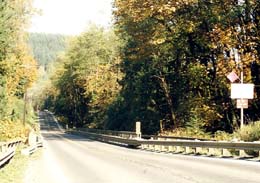On July 17, 1934, the Granite Falls Bridge opens with a gala dedication ceremony. The bridge spans the Stillaguamish River near Granite Falls in Snohomish County and represents an early and important step in the development of the Mountain Loop Highway, which will be completed in December 1941. The Granite Falls Bridge is still in use today (2007).
Mountain Loop Highway
Although trains had provided transportation into the Cascade Mountains east of Granite Falls since the 1890s, by the 1930s the Snohomish County Good Roads Association saw the need to create an automobile route through the same area. Named the Mountain Loop Highway, this road would follow a 55-mile route between Granite Falls and Darrington.
One of the first steps in building the Mountain Loop Highway came on July 17, 1934, with the opening of the Granite Falls Bridge over the South Fork of the Stillaguamish River. The bridge, located just over a mile and a half east of Granite Falls, replaced an older bridge that had been more difficult for travelers to access, and was a big step forward in paving the way for the automobile east into the mountains.
A Depression-era Bridge
The new bridge was built at a cost of more than $40,000, made up from county and Public Works Administration (PWA) funds. (The PWA was a government program created in 1933 as part of President Franklin D. Roosevelt’s (1882-1945) New Deal to help the American economy recover from the Great Depression.) Construction of the bridge seems to have gone smoothly; in a speech at the dedication, Snohomish County Commissioner Charles H. Smith claimed that no accidents had occurred during construction.
The 330-foot long, 20-foot wide steel-truss bridge is supported by a steel and concrete arch, and the roadway is 92 feet above the rushing Stillaguamish River below. Walkways flank the roadway on both sides of the bridge, and a glimpse of Granite Falls can be seen from the northern side.
Dedication
The bridge was dedicated on the afternoon of Tuesday, July 17. Hundreds of people drove out to the ceremonies and were met at the bridge approach by a 6-by-24-foot banner showing mountain scenery and reading “Beginning of the Mountain Loop Highway -- Granite Falls, Barlow Pass, Darrington -- Monte Cristo, Index -- Entrance to God’s Mountain Playground.” Flags decorated the bridge on both sides.
Ceremonies kicked off about 3 p.m. with a rousing tune played by the Eagles New Deal Band of Everett. Speakers sang the praises of the Mountain Loop Road in general and the Granite Falls Bridge in particular. Young Barbara Curtis and Barbara Ashe cut the ribbon stretching across the entrance to the bridge, and, led by a Boy Scout color guard and the Eagles New Deal Band, cars and a string of loaded pack animals (furnished by a local ranger) happily crossed the new bridge. “As the long line of cars went by the willing Eagles band discoursed music and with the sun shining and flags waving the scene was quite inspiring” (The Arlington Times, July 19, 1934, p. 1).
In 1934 the Mountain Loop Highway reached as far as a forest camp in Verlot, 11 miles east of Granite Falls. The crowd enjoyed a leisurely ride to Verlot and back, and then returned to the Canyon Creek Lodge east of Granite Falls for a late lunch. An evening program at 7 p.m. at the lodge came complete with solo singers, quartets, and the seemingly omnipresent Eagles New Deal Band, all of which thrilled the crowd. The main speaker was E. F. Banker, the director of the Washington State Department of Conservation and Development. Banker gave a prescient speech stressing the “sane use of our natural resources ... and that we ought to get away from the idea that we must cut the last tree and catch the last fish without thought of the future” (The Arlington Times, July 19, 1934, p. 4).
The Bridge and the Mountain Road
The Granite Falls Bridge is still in use today. A $3 million rehabilitation project for the bridge has been planned for several years to widen the bridge from 20 to 30 feet. The project, originally scheduled to take place in 2005, is now scheduled for the summer of 2008.
Construction of the Mountain Loop Highway continued through the 1930s and into the early 1940s. The final segment of the highway, from Barlow Pass to Darrington, was completed in December 1941.

